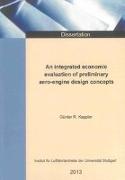- Start
- An integrated economic evaluation of preliminary aero-engine design concepts
An integrated economic evaluation of preliminary aero-engine design concepts
Angebote / Angebote:
Preceding the launch of an aero-engine development, every engine manufacturer is faced with the business decision whether the future economic revenues of an aero-engine project do or do not outweigh the costs of its development and successful integration into the market. This decision is substantially dependent on the engines' operating profitability for the airlines.
Within this work, a parametric model is presented that allows the repeatable application of comprehensive economic evaluations of aeroengines in the preliminary concept phase and delivers transparent results. The concept of the model emphasizes on the technical characteristics of aero-engines, namely performance, mass and dimensions, and places them in a comprehensive state of the art methodology for innovative product planning and realization. In the sense of innovation and technological management, the model is based on the principles of Life Cycle Cost accounting. It contains the business economics of the airline representing the final customer and the engine manufacturer within dynamic market conditions during the entire life cycle of the aeroengine. The evaluation of profitability for both the airline and the engine manufacturer is addressed by the individual net present value. This newly developed Enhanced Life Cycle Value Added module consists of five models, designed in a modular structure. An existing state of the art Life Cycle Value Added model serves as basis. The model addresses the economic evaluation of the airline. Market conditions are delivered by a newly developed dynamic air traffic market forecast model. An annual iteration accounts for the market dynamics. The key aspects of aeroengine related costs within the model such as block fuel, maintenance and unit price are refined to cope with current demands to identify the best alternative engine design for a specific application. To improve the accounting of the research and development efforts of the engine manufacturer, a cost model is created based on the principles of cost- and performance accounting. The improvement of fuel cost accounting for the block fuel required during engine operation is realized by the integration of an aircraft flight performance model. The model is derived from state of the art aircraft performance methodologies. To account for the economics of the engine manufacturer, a Life Cycle Value Addedmodel is created that comprises the key revenues and key costs of the engine manufacturer for a specific engine project.
The application of each of the five models contained in the Enhanced Life Cycle Value Added module is performed by calibration of the models' input data by means of comparisons to publicly available data where feasible, otherwise by scrutinizing the plausibility of each model result. The module's results of an economic evaluation that addresses three competitive aero-engines, illustrates the different profitability of the airlines and the engine manufacturers resulting from new engine developments. The dynamic integration of the market conditions within the Enhanced Life Cycle Value Added module allows the simulation of plausible scenarios for future developments. Based on variations of the market conditions, its significant effects on the profitability of an aeroengine project are illustrated
Libri-Titel folgt in ca. 2 Arbeitstagen

